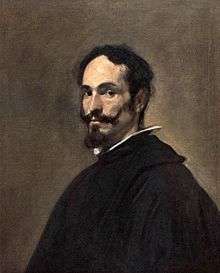John Snare

John Snare (born c.1811,[2] died c. 1883) was a bookseller and publisher from Reading, England, whose life was dominated by the discovery at a country house auction in 1845 of a hitherto lost Diego Velázquez painting, which Snare identified as a young Charles Stuart. It was supposed that the portrait was painted in 1623 during Charles' eight month visit to Spain where the future monarch failed in his attempt to secure the hand of the Spanish Habsburg princess Maria Anna. A protracted court case in Scotland with trustees from the estate of the Earl of Fife arose over the ownership of the work and this eventually brought Snare to financial ruin. Following the trial, Snare emigrated to New York City. After Snare's death, the Velázquez passed to Snare's son, and went on display briefly in 1885 at the Metropolitan Museum of Art. The painting has not been seen again since. No images of the work survive, only Snare's written descriptions of the painting.[3]
In 2016, Snare's story was told by Observer art critic Laura Cumming in her book, The vanishing man: In pursuit of Velazquez (Chatto & Windus).[4]
Selected publications
- The Post-Office Reading directory. Compiled ... by John Snare. John Snare, Reading, 1842.
- Snare's map of the country ten miles round Reading, compiled ... under the superintendence of M. Dodd. Reading, 1846. (map)
- The history and pedigree of the portrait of Prince Charles (afterwards Charles I) painted by Velasquez in 1623. 1847.
- A brief description of the portrait of Prince Charles, afterwards Charles the First, painted at Madrid, in 1623, by Velasquez: now exhibiting at No. 21, Old Bond Street, London. London, 1847.
References
- ↑ Portrait of a Man. BBC Your Paintings. Retrieved 14 January 2016.
- ↑ 1841 England, Wales & Scotland Census Transcription. Retrieved 14 January 2016.
- ↑ Cumming, Laura, The Vanishing Velázquez: A 19th-Century Bookseller's Obsession with a Lost Masterpiece, (Scribner, New York, April 2016).
- ↑ "How Velázquez gave me consolation in grief – and set me on the trail of a lost portrait", Laura Cumming, The Observer, 3 January 2016. Retrieved 14 January 2016.